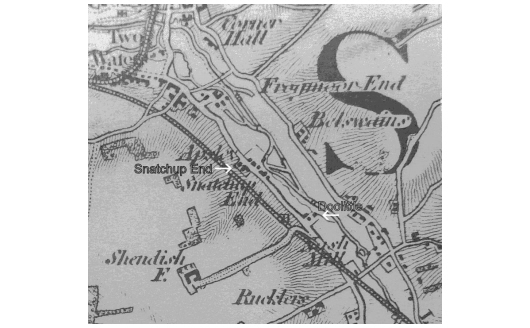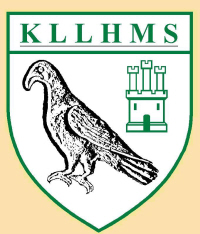Doolittle
Nearly opposite the entrance of the drive to Shendish is a roundabout designed to regulate traffic to and from the newly-constructed commercial site. A sign labels The Doolittle Meadows Business Park.

Newcomers may well wonder about the origin of the name Doolittle. It was the name of the hamlet nearby, and the meadow between the hamlet and Apsley Mills was Doolittle Meadow. The meadow in the opposite direction, that is, towards a the Red Lion, was Nash Mills meadow (Kings Langley parish map 1839). The Business Park now occupies a bit of both meadows, so it would have been more fitting to call it Doolittle Business Park, but I suppose that would not have conveyed the idea of a thriving go-ahead commercial centre. Incidentally, pre-war maps name a small copse on the other side of the railway line within the Shendish Estate as Doolittle plantation.
Before the road from Shendish was diverted at the railway line, it ran straight on to Doolittle, and before the canal was built it continued on to the Upper Highway, now Beswains Lane, near the present Post Office and Stores.
John Dickinson acquired Apsley Mills in 1809 and then went on to acquire or build other paper mills. He was soon employing workers in increasing numbers, and for their convenience and no doubt his own too he built dwellings for them near his various mills.
A row of four pairs of cottages were built by what is now Station Road, Kings Langley, near his Home Park Mills. The mills had been demolished, but the cottages are still occupied. It is said that like John Dickinson's house, Abbots Hill, they were built with only one external door. At Nash Mills a three storey block of six cottages was built at right angles to Beswains Lane between the Three Tuns public house and Nash Mills school. This building was demolished just after World War 11. Six blocks of four houses were built in Apsley by the canal and became known as Frogmore crescent; they too have gone. Another group of 12 houses was built at Doolittle, two terraces each of six homes facing each other across a grassed square in the middle of which was the communal pump.
Before Dickinson built his houses at Doolittle there existed another building, possibly sixteenth century, located by the canal. That building and the houses around the square were occupied by Dickinson employees up to the time they were knocked down about 1934.
No doubt originally the homes were made available to key workers to ensure they were close at hand in the event of a breakdown in production. The last occupant of the Doolittle cottages were all connected with Dickinson's and although not key workers many of them were members of Dickinsons fire brigade, thus well placed to respond quickly to an emergency.
For the record the list of the last occupants is given below. The house numbers started from the entrance by the London Road; on the right hand side were 1 to 6 and a then 7,8 and9 in the very old building and 10 to 15 on the other side of the square. Near the entrance was an old coach house. Each home had its own garden, and there will also allotments on the site for those who wanted them.
No 1 Mr. and Mrs. Danny Fortnum, gatekeeper Nash Mills
No 2 Mr. and Mrs. Childs, then Mr. and Mrs Ernie Hunt
No 3 Mr. and Mrs. Siddie Saunders, gatekeeper Nash Mills
No 4 Mr. and Mrs. Ted Parkin, gardener Nash Mills
No 5 Mrs Rolph
No 6 Mr. and Mrs. Bill Simmons, chauffeur Apsley Mills
No 7 Mr. and Mrs. Freddie Welch, firemen Apsley Mills
No 8 Mr. and Mrs. Cromack
No 9 Mr. and Mrs. Bill Breed Rule Book Dep't Apsley Mills
No 10 Mr. and Mrs. Harry Doult, foreman, Traffic Department AM and fireman
No 11 Mr. and Mrs. Whittaker, foreman Card Department AM and firemen
No 12 Mr. and Mrs. Bill Final, foreman Book Department AM and firemen
No 13 Mr. and Mrs. Bob Hampton, traffic yardsman AM
No 15 Mr. and Mrs Dabro Allan
(Names recalled by the late Bob Hampton)
After the demolition the site became a car park and during World War 11 a gas decontamination unit was built there as part of the air raid precautions.
The real point of interest is why is the place called Doolittle? One explanation given by a former manager of John Dickinson's who had the responsibility for the archives is that Doolittle was the name of a corn mill located there which belonged throughout the middle ages to the Abbey of Saint Albans. It was used at one time as a retreat for monks who were in need of respite from the rigours of the Saint Albans monastery. It was a place in which they “did little”.
It is interesting to note that in the Stationer and Fancy Trades Register 6th Oct 1880 there appeared an article in a series called “Our Wholesale Houses – Paper” which featured John Dickinson &Co. Here is an extract:
‘The name of the village close at hand, “Do little”, does not apply to the locality of the Mills under notice. If the slight fall of two feet on the water-wheel at one time to be found in the one mill at Do-Little gave a name to the village that is scarcely true, as regards the inhabitants, the more powerful waterfalls at Nash and Apsley and the amount of stirring hearty industry to be noted on every hand should earn for those mills the title of not only “Great Expectations” but of mighty accomplishment’.
This seems to indicate that at one time there was a mill at Doolittle. Perhaps the old 16th century house had been the mill at one time. Old maps certainly show it more or less on the River Gade. Remember, the article was written more than 100 years ago and seems to be taking into account local hearsay from the past.
That is all I’ve been able to glean. Possibly there is more to be found in ancient ecclesiastical records about Saint Albans Abbey, but that is a job for the professional historian. Meanwhile we can do little more than speculate!
Although demolished, Doolittle did not immediately fade into obscurity. The name was too good a target of derision for that. Before the last war and just after there were annual socials for the various departments of John Dickinson's held in the Apsley Guildhouse. There was professional and homemade entertainment. One such item at the Banker Envelope department in 1937 was a competition for the Doolittle Challenge Cup. Teams of six took part in a sort of hockey with a hassock instead of a ball and cardboard tubes instead of sticks. The “cup” was a large cardboard cut-out of the two-handled cup with a good head of foam at the top.
Victory was celebrated with the real thing
Reproduced by kind permission of Peter Ward.
Previously published in the KLLH&MS Newsletter 2012.
Please also see http://www.hertfordshire-genealogy.co.uk/data/census/census1881-doolittle.htm




